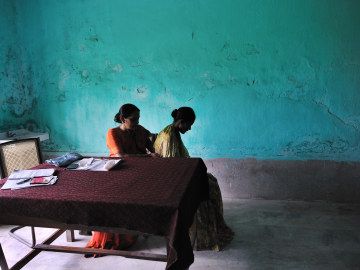End Mycetoma's Catch-22
For too long, the flesh-eating, bone-destroying disease mycetoma has been overlooked by global health authorities. In fact, it’s so neglected that it’s not on WHO’s official list of neglected diseases.
That’s a problem for those interested in fighting a disease that spreads misery through at least 23 countries though its burden within those countries is unknown. The lack of research about mycetoma’s prevalence is one reason it’s not on WHO’s list. Yet in order for foundations and government agencies to commit funds for even basic epidemiological studies on mycetoma, it needs to be on the list. It’s a Catch-22 that’s stymied much-needed research for decades.
WHO’s Executive Board members meeting this week in Geneva have an opportunity to potentially end this Catch-22. If they decide to add it to the agenda for the 2016 World Health Assembly meeting in May, policymakers from around the world may then decide to put mycetoma on the list.
Mycetoma deserves the world’s attention. Obscured by the glare of more prominent diseases, mycetoma afflicts the very poor in equatorial countries from Mexico to India. What researchers know is that it is not uncommon. A field study in an endemic area of White Nile State published in 2014 in PLOS Neglected Tropical diseases documented a prevalence of 14.5 per 1,000 population. Bacterial or fungal in origin, the disease starts with a skin infection that over time grotesquely swells feet and other appendages. It erupts in painful skin lesions and can destroy bone. Treatment for the fungal form (eumycetoma) is expensive, has to be taken for long periods and is frequently ineffective. Often the only treatment is amputation. Sometimes the disease proves fatal.
In the absence of extensive research, people continue to suffer. As Amy Maxmen documented in a Global Health NOW series on mycetoma called The Most Neglected Disease, mycetoma visits true horror upon human beings. Consider Wisal Altai, one of many people afflicted with mycetoma who shared their stories with Maxmen during a November 2015 visit to Sudan. Altai has had multiple surgeries on her foot to carve out the mycetoma fungus, and taken drugs with toxic side effects, but the infection persists.
Mustafa Alnour Alhassan had to have his leg amputated in June because of a mycetoma infection. It then spread to his groin and lungs. Alhassan showed Amy the last container of pills his family could afford—only enough for fewer than 50 days. Tragically, many others in Sudan and other countries face similar circumstances.
On Wednesday, things may start to change for people in the “mycetoma belt.” Among topics WHO’s Executive Board will discuss at this week’s meeting in Geneva is Item 9.4. Mycetoma.
The board will consider a resolution by Egypt, Nigeria and Sudan. The resolution calls on the 69th World Health Assembly and member countries to expand research into mycetoma and to support intervention and control efforts. The resolution also asks WHO finally add the disease to WHO’s neglected tropical diseases list.
This seems like a small step—adding a disease to a list on a website—but in fact it’s essential if things are to change. Funders, including major foundations, look to this list when deciding what type of research to support. We urge the WHO Executive Board to recommend the WHA approve the resolution and help start driving change.
Amy Maxmen is a freelance journalist who has published articles in Wired, The Lancet, Nature, Nautilus and The Economist. Brian W. Simpson is editor-in-chief of Global Health NOW.
Ed. Note: Opinions expressed in this commentary do not necessarily reflect those of the Johns Hopkins Bloomberg School of Public Health.
Join the thousands of subscribers who rely on Global Health NOW summaries and exclusive articles for the latest public health news. Sign up for our free weekday newsletter, and please share the link with friends and colleagues: Subscribe to GHN




